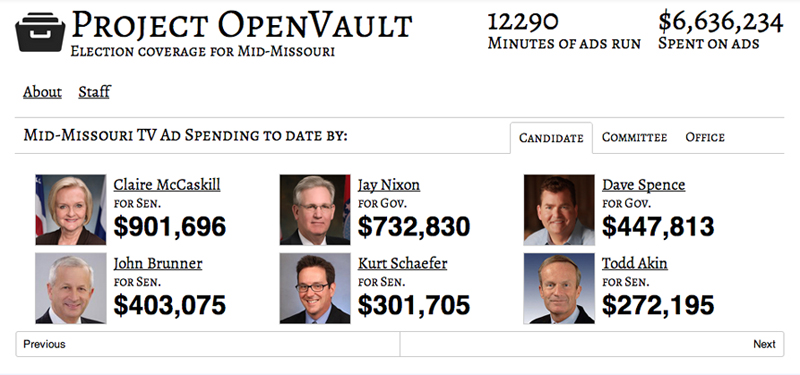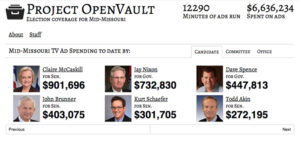Project Open Vault Website Offers New Platform for Election Coverage

The Missouri School of Journalism Project Focused on How Political Candidates Spend Money on Advertising
By Celia Darrough
Master’s Student
Columbia, Mo. (Nov. 19, 2012) — A team at the Missouri School of Journalism came together to analyze not only how much money political candidates devote to delivering their messages but also what messages the candidates are trying to deliver.
Project Open Vault combines the community-oriented newsrooms of the Columbia Missourian, KBIA-FM and KOMU-TV in an effort to cover the 2012 elections from a new angle.
The idea for the project began in late 2011. Faculty members met to discuss collaboration among the three newsrooms for the elections.
David Herzog, associate professor, said Project Open Vault, which is hosted on tumblr.com, consists of three main components: political advertisement data for the local television market, online engagement and general election news.

The team wanted to spotlight political advertising because that information is not generally available across the United States right now, Herzog said. By gathering ad contracts from television stations in Columbia and Jefferson City, members of the project could present the material in an interesting way and show how and why it is a factor in political races.
Matthew Patane, managing editor of Project Open Vault, drove each week to three television stations – KMIZ, KRCG and KOMU – to pick up paper copies or PDFs of the ad contracts, the only manner in which the contracts are made available. He then entered the information into a database that the team used to report and analyze.
As of last count, Missouri politicians had spent more than $6.6 million on television advertising.
For his online posts, Patane, a print and digital news senior, said he worked to tie the advertisements and his knowledge of election news together.
When Claire McCaskill’s campaign broadcasted an advertisement, “Think About Family,” in a subtle attempt to distance McCaskill from President Obama, Patane posted about how Republicans have cited her relationship with the president as evidence of McCaskill being unsuitable to represent Missouri.
Patane said the McCaskill and Todd Akin advertisements were particularly representative of the contentious nature of politics. Jay Nixon and Dave Spence’s advertisements were no exception, either.
“If you know the relationship between two candidates and see the ads, the relationship is apparent in the ads,” Patane said. “Those ads were a good model of how the campaign was shaping up.”
Engagement efforts were coordinated by Joy Mayer, director of community outreach at the Columbia Missourian, and Jen Reeves, who was the interactive director of KOMU-TV. Their students worked together to involve the audience in the content.
Each Monday, they posted a question on a political topic. They also created social media guides to following the election and Facebook and Twitter lists of candidates and election media.
But Project Open Vault wasn’t only about advertisements; posts also ranged from videos of residents expressing opinions and ideas to candidate interviews to a behind-the-scenes look at the struggles of election coverage.
Ryan Famuliner and Scott Pham, both of KBIA, contributed a bulk of posts about the candidates and often did so in a humorous way, Patane said. Reporters on the Columbia Missourian’s public life beat, which is managed by city editor Scott Swafford, also contributed posts.
Mayer said the conversational approach is a fantastic complement to political coverage.
Project members are still trying to decide what will happen to the website now that elections have concluded.
Patane said he hopes it might become part of a class, preferably a data-driven capstone that is its own entity with its own dedicated team or adopted by one of the newsrooms for future coverage.
Regardless of what happens, Herzog said, it has been a great experience and learning opportunity for all the people involved.
“I just think it’s a great example of collaboration that, individually, none of the newsrooms would have been able to do,” he said. “Involving students from all different sequences is really what made this happen.”
Project expenses were paid by funds from the Houston Harte Chair, which is focused on supporting innovative journalism experiments.
Updated: July 10, 2020